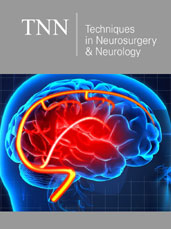- Submissions

Full Text
Techniques in Neurosurgery & Neurology
Spasticity Treatment Strategies in Multiple Sclerosis
Behzad Saberi*
Medical Research, Esfahan, Iran
*Corresponding author: Behzad Saberi, Medical Research, Esfahan, Iran
Submission: August 27, 2019;Published: October 30, 2019

ISSN 2637-7748
Volume3 Issue1
Mini Review
Yoga, aquatherapy and stretching can be used to manage mild levels of spasticity in the patients with multiple sclerosis. In more severe cases which spasms interfere with normal functions and sleep, drug therapy would be indicated. As monotherapy, Baclofen can be the first choice which stimulates the GABA receptors. Administration of Baclofen with the initial dosage of 5 to 10mg three times a day and in case of necessity, increasing the administered dosage to achieve a therapeutic response or reaching the maximum tolerated dosage which can be more than 100mg in some patients, can be a good therapeutic strategy. Nocturnal spasms can be controlled by bedtime administration of the drug. Sedation, muscle weakness and confusion can be the side effects of the Baclofen which can make its clinical usage, limited.
Bladder function may be improved or worsened unpredictably during treatment with Baclofen. When the daily dosage of administration of Baclofen is more than 30mg, abrupt discontinuation of the drug is prohibited because of the risk for occurring withdrawal syndrome which its clinical picture includes seizures, confusion etc.
Tizanidine as an a-adrenergic agonist can be another treatment option. It is best to be initiated very slowly which is started with 2mg at bedtime and gradually increased and adjusted to a maximum dosage of 12mg three times a day. Dry mouth, orthostatic hypotension and sleepiness are the main side effects of treatment with Tizanidine. Occurrence of motor weakness with Tizanidine treatment is lower than treatment with Baclofen. Combination therapy with low doses of Tizanidine and Baclofen can be effective with successful therapeutic results.
Benzodiazepines and Gabapentin can be another treatment options due to their musclerelaxant effects. Continuous intrathecal Baclofen administration can be used in cases with severe spasticity. Injection of Botulinum toxin can also be used for spasticity treatment in occasional cases, although its effectiveness for larger muscle groups is not so much. Also, for such cases, there are some technical difficulties which make treatment with Botulinum toxin injections, limited.
Dantrolene sodium, Clonidine and Cyproheptadine-among others-can also be used to treat spasticity in the patients with multiple sclerosis [1-11].
References
- Young R (1994) Spasticity: a review. Neurology 44(11 Suppl 9): S12-S20.
- Feldman R, Kelly-Hayes M, Conomy J, Foley J (1978) Baclofen for spasticity in multiple sclerosis. Double-blind crossover and three-year study. Neurology 28(11): 1094-1098.
- From A, Heltberg A (1975) A double-blind trial with baclofen (Lioresal) and diazepam in spasticity due to multiple sclerosis. Acta Neurol Scand 51(2): 158-166.
- Cendrowski W, Sobczyk W (1977) Clonazepam, baclofen and placebo in the treatment of spasticity. Eur Neurol 16(1-6): 257-262.
- Penn RD, Savoy SM, Corocs D, Latash M, Gottlieb G, et al. (1989) Intrathecal baclofen for severe spinal spasticity. N Engl J Med 320(23): 1517-1521.
- Azouvi P, Mane M, Thiebaut J, Denys P, Remy-Neris O, et al. (1996) Intrathecal baclofen administration for control of severe spinal spasticity: functional improvement and long-term follow-up. Arch Phys Med Rehabil 77(1): 35-39.
- Brar S, Smith M, Nelson L, Franklin GM, Cobble ND (1991) Evaluation of treatment protocols on minimal to moderate spasticity in multiple sclerosis. Arch Phys Med Rehabil 72(3): 186-189.
- Lapierre Y, Bouchard S, Tansey C, Gendron D, Barkas WJ, et al. (1987) Treatment of spasticity with tizanidine in multiple sclerosis. Can J Neurol Sci; 14(3 Suppl): 513-517.
- Kerty E, Stein R (1997) Treatment of spasticity with botulinum toxin. Tidsskr Nor Laegeforen 117(14): 2022-2024.
- Shakespeare D, Young C, Boggild M (2003) Anti-spasticity agents for multiple sclerosis. Cochrane Database Syst Rev 4.
- Dunevsky A, Perel A (1998) Gabapentin for relief of spasticity associated with multiple sclerosis. Am J Phys Med Rehabil 77(5): 451-454.
© 2019 Behzad Saberi. This is an open access article distributed under the terms of the Creative Commons Attribution License , which permits unrestricted use, distribution, and build upon your work non-commercially.
 a Creative Commons Attribution 4.0 International License. Based on a work at www.crimsonpublishers.com.
Best viewed in
a Creative Commons Attribution 4.0 International License. Based on a work at www.crimsonpublishers.com.
Best viewed in 







.jpg)






























 Editorial Board Registrations
Editorial Board Registrations Submit your Article
Submit your Article Refer a Friend
Refer a Friend Advertise With Us
Advertise With Us
.jpg)






.jpg)














.bmp)
.jpg)
.png)
.jpg)










.jpg)






.png)

.png)



.png)






